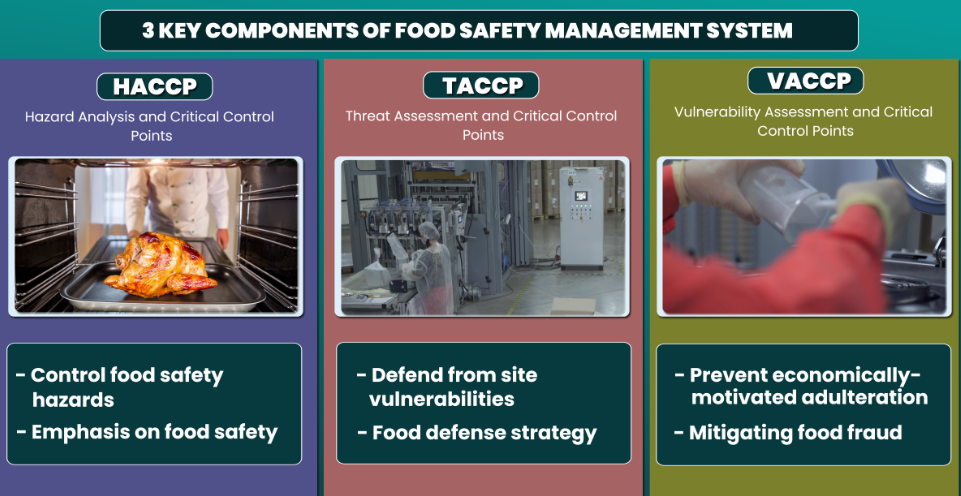
Most food industry professionals are familiar with HACCP, or Hazard Analysis Critical Control Point, as a cornerstone in ensuring food safety. However, two other lesser-known components namely, TACCP and VACCP stand for Threat Assessment Critical Control Points and Vulnerability Assessment Critical Control Points, respectively, are equally crucial in this scenario.
While their names may sound similar and their acronyms may flow off the tongue with ease, understanding the nuances and significance of each is critical for safeguarding the integrity of the food supply chain. Let’s delve into the distinctions among these three management systems and explore their unique roles in maintaining food safety and security.
Hazard Analysis and Critical Control Point (HACCP) stands as a globally recognized framework for managing food safety, crucial for ensuring that food processors deliver a safe end product. Initially developed by Pillsbury in the early 1960s to provide safe food for the space industry, following a request from NASA, it has since become a staple in the food industry, standardized by The Codex Alimentarius Commission (CAC) and implemented in the EU through Commission Regulations 852/2004 and 853/2004.
As a systematic approach, HACCP facilitates the identification and evaluation of potential hazards in food production while establishing preventive measures for these hazards. By emphasizing hazard prevention, it reduces the need for traditional inspection and reliance on end-product testing.
The versatility of the HACCP concept allows for its application to both new and existing products and processes, spanning the entire food chain from primary production to consumption. Moreover, it seamlessly integrates with existing quality management systems, such as the ISO 9000 series, wherein HACCP has been incorporated to create an integrated quality and safety standard, ISO 22000.
The framework of HACCP comprises seven principles outlined by Codex, which must be meticulously followed for its successful implementation:
Conduct hazard analysis
Identify Critical Control Points (CCPs)
Set critical limits at CCPs
Monitor critical limits
Implement corrective actions when control at CCPs is compromised
Verify the effectiveness of the HACCP system
Document procedures and maintain appropriate records curated to the process.
TACCP, standing for Threat Assessment and Critical Control Points, is a proactive approach to safeguarding against deliberate threats to food safety. TACCP is defined as a management process, a systematic method, to defend a food supply chain from intentional contamination. The act of contamination is behaviorally or ideologically motivated with the intent to cause harm to people. It requires a broader spectrum of employee involvement, covering areas like plant security, transportation security, IT security, and personnel background checks. Unlike HACCP, which primarily targets unintentional hazards, TACCP is concerned with intentional acts such as product tampering, substitution of ingredients, and false labeling for economic gain.
VACCP, or Vulnerability Assessment and Critical Control Points, complements TACCP by identifying vulnerable points in the supply chain susceptible to economically motivated adulteration (EMA). VACCP is defined as a management process, a systematic method, to defend a food supply chain from any form of dishonest conduct that impacts negatively on the quality, integrity, or authenticity of food and drink. The “dishonest conduct” is motivated by economic gain. This includes food fraud activities like product substitutions, counterfeiting, and unauthorized enhancements.
TACCP and VACCP plans entail rigorous risk assessments to identify probable threats and vulnerabilities, followed by employing the control measures at critical points throughout the production, processing, and distribution stages. Key controls may include stringent supplier vetting procedures, robust physical security measures, employee training programs on recognizing suspicious activities, regular audits and inspections, and effective crisis management protocols.
Supplier Assurance Systems: This involves implementing rigorous measures to ensure that suppliers comply with stringent quality and safety standards. This may include conducting supplier audits, inspections, and certifications to verify their adherence to food safety protocols.
Supply Chain Traceability: Tracking the movement of ingredients and products throughout the supply chain facilitates detecting and preventing unauthorized activities such as substitution, adulteration, or diversion.
Product Specifications and Checks: Regular inspections and testing protocols should be implemented to verify compliance with these specifications and to detect any deviations that may indicate adulteration or fraud.
Personnel Recruitment and Management: Background checks, ongoing training on food safety and security protocols, and implementing access controls are essential measures to mitigate the risk of intentional adulteration by employees.
Non-compliance Management: Developing protocols for handling non-compliant products is essential to minimize the impact of adulterated or fraudulent goods on consumers and the company’s reputation.
Site Security Controls: Enhancing security measures at manufacturing facilities is crucial to prevent unauthorized access, tampering, or contamination of food products.
IT Security Strategies: Safeguarding digital systems and data from cyber threats and hacking attempts is essential to protect sensitive information related to food safety and security.
In conclusion, TACCP and VACCP represent innovative approaches to fortifying food safety systems against intentional threats and vulnerabilities. While they depart from the traditional HACCP framework, their focus on proactive risk management and preventive measures is crucial in today’s complex food industry landscape.
How Smart Food Safe can Help Your Food Enterprise Build Efficient HACCP, TACCP & VACCP Programs?
Smart Food Safe brings forward tech-assisted tools that equip food businesses to develop game-changing HACCP, TACCP, and VACCP programs to facilitate precise and proactive risk assessment and management mechanisms to be on the lookout for food fraud and back food defense activities.
Conduct comprehensive risk assessments with Smart Supplier to evaluate supplier risks and ensure a robust supply chain. Utilize Smart Doc to establish clear policies and procedures for effective risk management, supported by Smart Specification for meticulous documentation of control and verification requirements. Empower your workforce with Smart Training, ensuring every employee is equipped with the knowledge and skills to uphold food defense standards. Streamline control checklist management and verification processes with Smart Record, while Smart Visitor enhances site security by mitigating visitor risks.
_1.png)